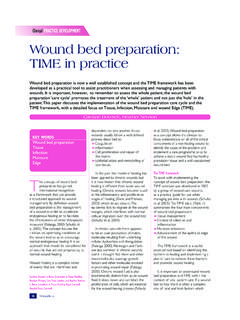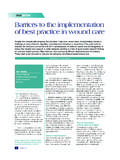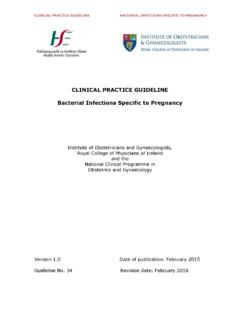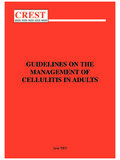Transcription of Secondary intention - Medetec Surgical Dressings …
1 Mechanisms of healing 27. alignment of the fibres also permits the formation of cross-links which lend further stability to the new tissue. Secondary intention In wounds that have sustained a significant degree of tissue loss as a result of surgery or trauma, it may sometimes be undesirable or impossible to bring the edges of the wound together. In these situations the surgeon may favour leaving the wound open to heal by Secondary intention . A similar decision may be taken if there is considered to be a serious risk of infection, or if there is a likelihood of subsequent wound dehiscence. It has also been found that healing by Secondary intention can sometimes give better results than primary closure or split-skin grafting, where the cosmetic results of the latter method can be marred by contraction, wrinkling and Although the basic mechanisms of healing of granulating wounds are similar to those that occur in wounds that heal by primary closure, there are significant differences, particularly in the relative duration of the various stages of the healing process.
2 Like a sutured wound , a defect that is left to heal by Secondary intention first undergoes an inflammatory response. During this time the exposed tissue or defect may become covered or filled with a layer of blood or serous fluid, which is released during or soon after the initial injury. As a result of increased capillary and venous permeability, erythrocytes, leucocytes and platelets are liberated into the wound . Neutrophils predominate during the first two to three days but as these decrease in number they are followed by macrophages, which reach their maximum level on day five or six. As in a sutured wound , macrophages are responsible for the bulk of phagocytic activity but they also produce a host of complex proteins and extracellular products including a chemotactic factor, which is thought to attract fibroblasts to the wound area.
3 Fibroblasts appear in the base of the developing wound as early as day four or five and are responsible for the production of intracellular precursors of collagen, which are eventually made into collagen fibrils extracellularly. This process of collagen production is thought to be at least partially under macrophage control. Around the second or third day, endothelial cells appear in the developing inflammatory tissue as capillary buds. Knighton et have suggested that the low oxygen tension in the centre of the wound in some way attracts macrophages, the only cells that are able to withstand the severe hypoxia in this situation. The macrophages clear away portions of the fibrous clot and liberate growth factors which stimulate the production of a capillary network. These capillaries retain their permeable nature and thus provide a constant source of cells and fluid for the developing tissue.
4 When the process of repair is complete the demand for oxygen is substantially reduced and much of this new vasculature is lost. During healing, the wound becomes progressively filled with granulation tissue, which is composed of collagen and proteoglycans, a complex mixture of proteins and polysaccharides together with salts and other colloidal materials which together produce a gel-like matrix contained within the fibrous collagen network. The production of granulation tissue continues until the base of the original cavity is almost 28 Mechanisms of healing level with the surrounding skin. At this stage, the epithelium around the wound margin becomes active and begins to grow over the surface of the wound , thus restoring the integrity of the epidermis. Occasionally the production of granulation tissue continues after the wound cavity has been filled, leading to the formation of hypergranulation tissue' or proud flesh'.
5 This is sometimes associated with the use of occlusive Dressings , and is often removed by the application of a caustic agent such as a silver nitrate pencil. A less traumatic method involves the short-term local application of a suitable corticosteroid cream or ointment, although this should only be done under medical supervision. Alternatively, a change to a more permeable dressing may be all that is required. The formation, causes and management of hypergranulation tissue have been reviewed A further, and equally important, part of the healing process is contraction, a mechanism by which the margins of the wound are drawn towards the centre. This produces a small area of scar tissue, which may be only one-tenth of the size of the original wound . Contraction may take place in all healing wounds, but it is particularly important in large wounds that are left to heal by granulation and epithelialization.
6 Although in many anatomical sites the process of contraction results in a wound with an acceptable cosmetic appearance, contraction of a wound on the face may result in distortion of the features due to the purse string' effect. Contraction takes place at a rate of approximately - mm/day and is not related to wound size, although it is known that rectangular wounds contract more rapidly than round ones. It has been shown that the contractile forces can be sufficiently powerful to cause severe loss of function,9 and in wounds on the dorsum of the hand they have even been known to cause dislocation of the wound contraction generally begins about the end of the first week and may continue until the wound is completely closed. It is brought about by the action of a specialist cell called a myofibroblast which is formed from a normal fibroblast as a result of major structural and functional changes.
7 Myofibroblasts show many of the properties of both fibroblasts and smooth muscle cells and will respond to agents that cause contraction or relaxation of smooth muscle tissue. The cells are joined together over the entire wound surface; when they contract they gradually pull in the edges of the wound . Some early evidence suggests that there may be a connection between the initiation of myofibroblast activity and the state of hydration (or dehydration) of the surface of the The process of contraction takes place most quickly if a wound is clean and free of infection and is slowed down or prevented altogether by the presence of eschar or adherent The healing of traumatic injuries, in which large areas of skin are lost, depends upon the extent of the damage. Superficial and shallow partial thickness burns, for example, heal as the surviving epidermal cells begin to grow and spread across the surface of the wound .
8 In deep dermal burns, these epidermal cells can develop from small numbers of surviving cells present in the lower parts of hair follicles and sweat glands. These will grow up onto the surface of the wound and appear as isolated islands which gradually increase in size, eventually merging together. If a burn has been severe, the survival of these isolated areas of epidermis may be prejudiced by dehydration or an inappropriate method of treatment. In full thickness burns all Mechanisms of healing 29. epidermal elements are lost; without the application of a skin graft, resurfacing of the wound can only take place by migration of epithelial cells from the wound margins, and healing is therefore very slow. Delayed primary closure Less commonly used than the other methods of healing, delayed primary closure is generally carried out when, in the opinion of the surgeon, primary closure may be unsuccessful due to the presence of infection, a poor blood supply to the area, or the need for the application of excessive tension during closure.
9 In these circumstances, the wound is left open for about three to four days before closure is effected. In these situations, sutures may be inserted at the time of the operation but left loose. Grafting and flap formation A skin graft is a portion of skin composed of dermis and epidermis that is removed from one anatomical site and placed onto a wound elsewhere on the body. If successful, grafting ensures that the wound will heal rapidly, thus reducing the chances of infection and the time spent in hospital. The major disadvantage of this technique is that the patient finishes up with two wounds instead of one, and it is often reported that the pain associated with the donor site is worse than that occasioned by the original injury. Most commonly used are partial thickness or split thickness grafts. These range in thickness from about 125 to 750 microns, although grafts 300 - 375 microns thick are typically employed.
10 These are removed from a suitable donor site, such as the thigh or buttock, using a special knife which can be preset to ensure that the harvested material is of the required thickness. As elements of epidermal tissue remain in the base of sebaceous glands and hair follicles, the donor site heals rapidly, usually within 10-14 days. For more specialist applications, such as facial reconstruction, full thickness grafts can be taken which may contain fat, hair and sebaceous glands. They have the advantages that they are cosmetically more acceptable and less likely to form severe contractures than split thickness grafts. Full thickness grafts are also used when a neurovascular bundle or cortical bone must be covered with tissue. They have the disadvantage that, in many cases, the donor site will itself require the application of a second, partial thickness graft, if the wound is too large to be closed by suture.






